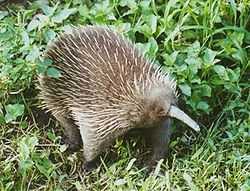Long-beaked echidna
| Long-beaked echidnas[1] | |
|---|---|
 | |
| Western Long-beaked Echidna (Zaglossus bruijni) | |
| Scientific classification | |
| Kingdom: | Animalia |
| Phylum: | Chordata |
| Class: | Mammalia |
| Order: | Monotremata |
| Family: | Tachyglossidae |
| Genus: | Zaglossus Gill, 1877 |
| Type species | |
| Tachyglossus bruijni Peters and Doria, 1876 | |
| Species | |
|
Zaglossus attenboroughi | |
The long-beaked echidnas make up one of the two extant genera (genus Zaglossus) of echidnas, spiny monotremes that lives in New Guinea. The Long-beaked Echidna is also found in Australia.[2] There are three living species and two extinct species in this genus. Echidnas are one of the two types of mammals that lay eggs, the other being the platypus. The echidnas are one of the last survivors of the earliest living mammals and are one of the first to show signs of evolution.[3] Also the long-beaked echidna is listed as endangered by the World Conservation Union.[4]
Species
Zaglossus attenboroughi
- Habitat: regions of New Guinea at higher elevation than highland forests
- Era: the present
- Critically endangered[5]
Zaglossus bartoni
- Habitat: on the central cordillera between the Paniai Lakes and the Nanneau Range, as well as the Huon Peninsula
- Era: the present
- Critically endangered[6]
Zaglossus bruijni
- Habitat: highland forests of New Guinea
- Era: the present
- Critically endangered[7]
†Zaglossus hacketti
- Habitat: Western Australia
- Era: Upper Pleistocene
- Fossil
- This species is known only from a few bones. At a metre long, it was huge for an echidna and for monotremes in general.
†Zaglossus robustus
- Habitat: Tasmania
- Era: Pleistocene
- Fossil
- This species is known from a fossil skull about 65 cm long.
- It had many spikes along its back to protect it from its predators and used them as a weapon.
General Information
The long-beaked echidna is larger than the short-beaked and has fewer, shorter spines scattered among its coarse hairs. The snout is two-thirds of the head length and curves slightly downward. There are five digits on both hind and forefeet, but on the former, only the three middle toes are equipped with claws. Males have a spur on each of the hind legs. This echidna is primarily a nocturnal animal that forages for its insect food on the forest floor. The animals are not usually foraging in the daylight. The long-beaked echidna lives in dens and they are commonly found to be in underground burrows.[8] The breeding female has a temporary abdominal brood patch, in which her egg is incubated and in which the newborn young remains in safety, feeding and developing. Since they reproduce by laying eggs and are incubated outside of the mother’s body it is accompanied by the prototherian lactation process show that they are early mammals. The long-beaked Echidna has a short weaning period. During this time milk is their only source of nutrition and protection for the hatchlings; they are altricial and immunologically naive.[2] Little is known about the life of this rarely seen animal, but it is believed to have similar habits to those of the short-beaked echidna. The population of echidnas in New Guinea is declining because of forest clearing and overhunting, and the animal is much in need of protection.
See also
- Fossil Monotremes
References
- ↑ Groves, C. P. (2005). "Order Monotremata". In Wilson, D. E.; Reeder, D. M. Mammal Species of the World (3rd ed.). Johns Hopkins University Press. pp. 1–2. ISBN 978-0-8018-8221-0. OCLC 62265494.
- ↑ 2.0 2.1 Bisana S, Kumar S, Rismiller P, Nicol SC, Lefe`vre C, et al. (2013) Identification and Functional Characterization of a Novel Monotreme- Specific Antibacterial Protein Expressed during Lactation. PLoS ONE 8(1): e53686. doi:10.1371/journal.pone.0053686
- ↑ Werneburg, Ingmar, and Marcelo R. Sanchez-Villagra. "The Early Development of the Echidna, Tachyglossus." Acta Zoologica 92 (2011.): 75-88. EBSCOhost. Web. Apr.-May 2013.
- ↑ Oplang, Muse D. "HOME RANGES, MOVEMENT, AND DEN USE IN LONG-BEAKED ECHIDNAS, ZAGLOSSUS BARTONI, FROM PAPUA NEW GUINEA. Full Text Available." Journal Of Mammology 90 (2009): 340-46. EBSCOhost. Web. 18 Apr. 2013
- ↑ Leary, T., Seri, L., Flannery, T., Wright, D., Hamilton, S., Helgen, K., Singadan, R., Menzies, J., Allison, A., James, R., Aplin, K., Salas, L. & Dickman, C. (2008). Zaglossus attenboroughi. In: IUCN 2008. IUCN Red List of Threatened Species. Retrieved 28 December 2008. Database entry includes justification for why this species is listed as critically endangered.
- ↑ Leary, T., Seri, L., Flannery, T., Wright, D., Hamilton, S., Helgen, K., Singadan, R., Menzies, J., Allison, A., James, R., Aplin, K., Salas, L. & Dickman, C. (2008). Zaglossus bartoni. In: IUCN 2008. IUCN Red List of Threatened Species. Retrieved 28 December 2008. Database entry includes justification for why this species is listed as critically endangered.
- ↑ Leary, T., Seri, L., Flannery, T., Wright, D., Hamilton, S., Helgen, K., Singadan, R., Menzies, J., Allison, A., James, R., Aplin, K., Salas, L. & Dickman, C. (2008). Zaglossus bruijnii. In: IUCN 2008. IUCN Red List of Threatened Species. Retrieved 28 December 2008. Database entry includes justification for why this species is listed as critically endangered
- ↑ Oplang, Muse D. "HOME RANGES, MOVEMENT, AND DEN USE IN LONG-BEAKED ECHIDNAS, ZAGLOSSUS BARTONI, FROM PAPUA NEW GUINEA. Full Text Available." Journal Of Mammology 90 (2009): 340-46. EBSCOhost. Web. 18 Apr. 2013.
- Flannery, T.F. and Groves, C.P. 1998. A revision of the genus Zaglossus (Monotremata, Tachyglossidae), with description of new species and subspecies. Mammalia, 62(3): 367–396
External links
| Wikispecies has information related to: Zaglossus |
| Wikimedia Commons has media related to Zaglossus. |
- EDGE of Existence (Zaglossus spp.) – Saving the World's most Evolutionarily Distinct and Globally Endangered (EDGE) species
- ARKive – images and movies of the long-beaked echidna (Zaglossus spp.)
- A summary, including references, on animalinfo.org
- (Long Necked) Echidna find rewrites natural history books - 'Mount Anderson, West Kimberley'
| |||||||||||||||||||||